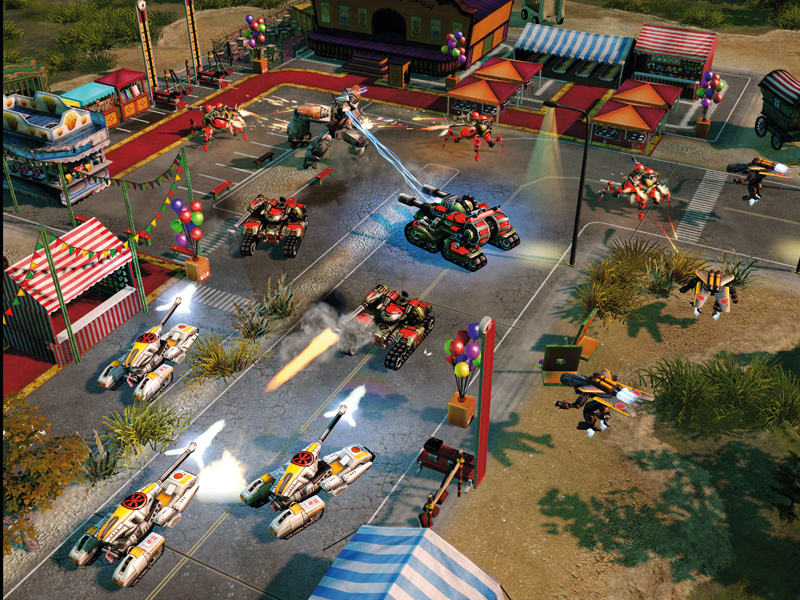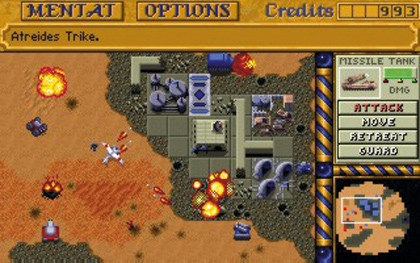The past, present and future of RTS gaming
Epic battles and eternal skirmishes revisited

Rommel, you magnificent bastard, I read your blog every day! There's nothing more satisfying than sitting back and watching an impressive army of tanks, rocket troopers, orcs, or whatever else happens to be in your unstoppable electronic army march roughshod across anything that gets in your way.
Whether it's part of some great scripted campaign, or simply a skirmish against a friend, it's the only chance most of us are going to get to feel like the great general, unleashing hell on all who dare oppose us.
Real-time strategy games haven't changed a vast amount over the years. The technology has improved, the experience sharpened up, and there have been a number of games that have put a unique spin on the action, but for the most part, the basics remain unchanged.
A good RTS will usually be a mix of rock-paper-scissors, economics, multitasking and micromanagement. You will need to not only know that, for instance, pikemen defeat cavalry while cavalry beat archers, but have the cash and foresight to have built them up in advance.
You'll also need to defend a base on one side of the map while simultaneously leading an assault elsewhere. And you need to do all this at speeds that make the average deathmatch seem quite a slow-paced affair by comparison. And that's just to play at a competent level.
Back in time
The first accepted RTS on PC was 1993's Dune II, the sequel to a largely unrelated and mostly forgotten adventure/strategy hybrid. It wasn't the first RTS ever made, a credit that usually goes to Herzog Zwei (1989) among console fans, or Stonkers (1984) if the audience remembers the ZX Spectrum, but Dune II set the general rules that are still followed today.
Get daily insight, inspiration and deals in your inbox
Sign up for breaking news, reviews, opinion, top tech deals, and more.

Mouse control, resource management, technology trees, a choice of factions with their own specialities and playing styles (three of them in Dune's case, although two tends to be more common, purely for balance purposes), mobile construction yards, superweapons, base building; all the core elements.
Compare Command and Conquer (1995) to Command and Conquer 3 (2007) and it's still recognisably the same game – certainly more so than comparing Doom (1993) with its own long-awaited third game, or Super Mario Bros with Super Mario Galaxy.
One of the main reasons for this is that while the technology has evolved, many of the standards became established as how the genre had to work. One of the strangest is that RTS games – particularly fantasy themed ones – love to have us build not simply a forward base but a whole city, complete with everything from training camps to cathedrals.
The idea of simply sending an actual army into battle, as opposed to showing up outside the enemy base with two generic grunts, a couple of peasants, and easy access to stone and timber… well, it's just ridiculous! More futuristic games have the equally ridiculous ability to not only capture individual buildings by sending one guy in, but sell them for cash at a moments notice. Imagine the adverts for that! "GDI Barracks for sale in middle of fully operational GDI Base. $5,000. Buyer collects…"
Nobody pretends this is realistic, but rather part of the game structure. Most RTS games are more about economics than actual tactics. It doesn't matter how good you are as a general, if you can't match your opponent's spending power, you're screwed.
The cash system, and with it, the need to keep investing in the good weapons rather than just unloading them from the docks, helps provide the game's power curve, taking you from effectively unarmed scouting through to nukes and time machines. The result is that the army you fight with is the army you've built up, making it much more satisfying, even if the learning curve for each game can take some serious climbing.
The conquering heroes
During the 1990s, three companies came to own the RTS genre: Blizzard, Westwood, and Microsoft. Westwood set the pace with Command and Conquer (1995), bringing us the first battle between the United Nations (GDI) and the less than scary sounding Brotherhood of Nod.
Blizzard was actually in the game earlier, releasing Warcraft: Orcs and Humans in 1994, but it wasn't until the sequel, Warcraft II: Tides of Darkness, that the series really took off. Its successor, Starcraft (1998), remains arguably the best RTS of the era, with three completely different races to play as, almost complete asymmetry in terms of their abilities, and a terrific storyline that fans still want to see finished.
Microsoft's contribution was slightly more subtle. Age of Empires (1997) combined the RTS action of the Warcraft games with something closer to Civilisation. Instead of simply building more stuff, your army levelled up through multiple technological ages.
Its pattern was quickly borrowed/blatantly ripped off by many other developers, most notably Settlers V (a series that had previously focused much more on village economics and the prettiness of building a working settlement), before being honed to perfection in Rise of Nations by Civilization 2/Alpha Centauri creator, Brian Reynolds.
Other key games of this era included Total Annihilation (1997), which wasn't as tactically fun as the other games, but offered more units than a dozen other games, the Bitmap Brothers' Z (1997) which put the focus on controlling territories and giving units a sense of personality – albeit mostly telling you how much you sucked, given the nightmarish difficulty level – and the disappointing Command and Conquer: Tiberian Sun (1999), which marked the beginning of Westwood's decline.
Blizzard on the other hand rocked the world with Warcraft III (2002), paving the way for some online RPG or other that a few people still play. It's fairly obscure. Don't worry if you've never heard of it.